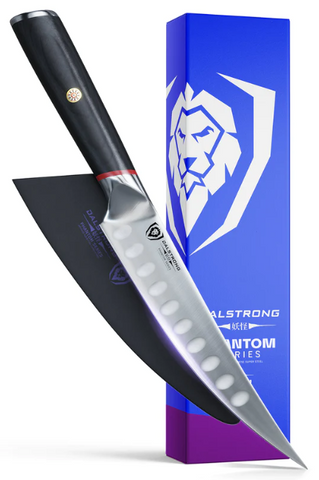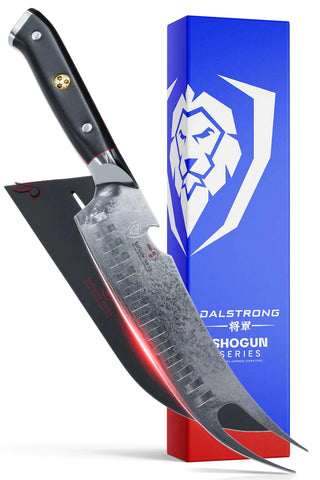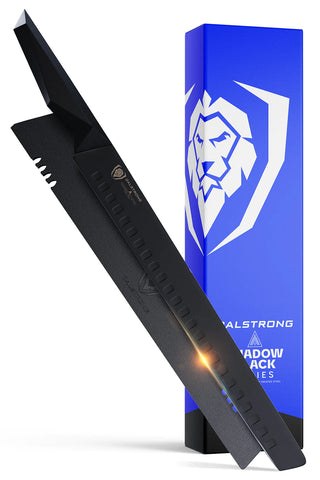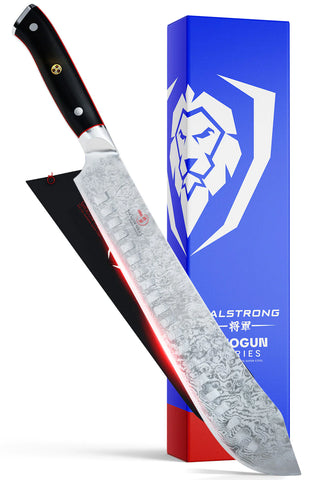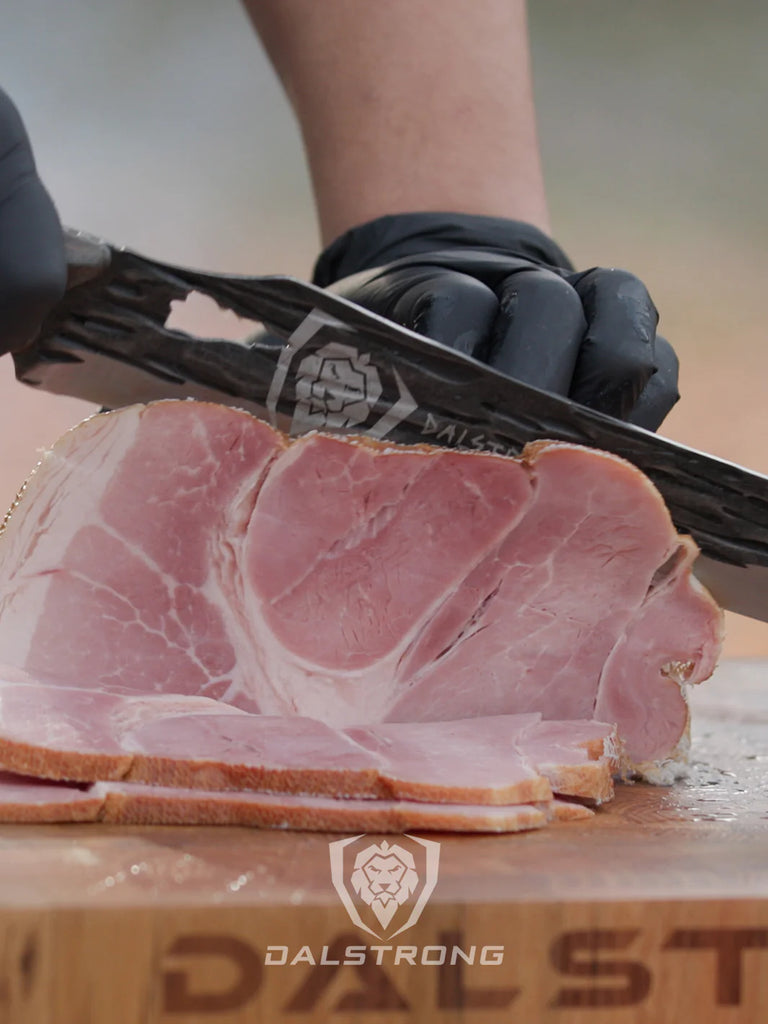
Quick Overview: How To Cut Meat Against the Grain
- Begin by examining the meat to identify the direction of the muscle fibers, known as the grain.
- Ensure a clean and organized cutting surface.
- A sharp knife is crucial for clean cuts.
- Place the meat on the cutting surface.
- Remember that cutting against the grain means slicing perpendicular to the direction of the muscle fibers.
- Adopt a steady and consistent slicing motion to maintain uniformity throughout the cutting process.
- While cutting, use even pressure to smoothly slice through the meat fibers without tearing.
- Strive for uniform slices to guarantee even cooking and a consistent texture in the final dish.
- Pay attention to the desired thickness of the slices, adjusting your cutting technique accordingly.
- Continue cutting across the entire piece of meat, following the identified grain direction.
1. What Is Meat Grain?
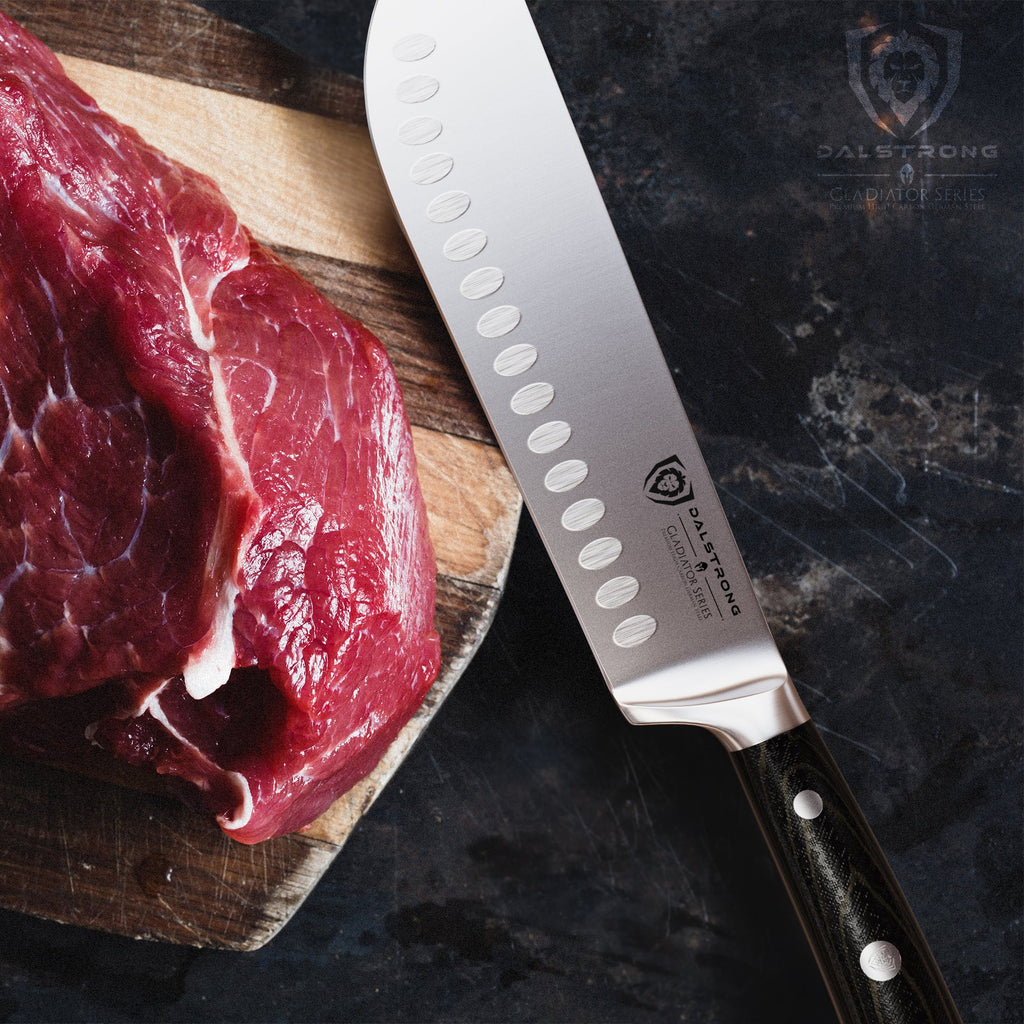 Bull Nose Butcher & Breaking Knife 8" | Gladiator Series | NSF Certified | Dalstrong
Bull Nose Butcher & Breaking Knife 8" | Gladiator Series | NSF Certified | Dalstrong
Meat grain refers to the direction in which the muscle fibers run within a cut of meat. Imagine these fibers as tiny threads composing the meat. To understand it better, think about slicing a loaf of bread. The grain, in this case, is similar to the alignment of the bread slices. Knowing the direction of the meat grain is crucial for achieving a tender and flavorful bite.
Texture
To determine the meat grain, look for the lines running across the meat's surface. These lines represent the muscle fibers' direction. Slicing against the grain is a cooking tip that applies to various cuts, including flank steak, skirt steak, and hanger steak. Mastering the understanding of meat grain ensures that each slice of your favorite cut is not only visually appealing but also a delight to the taste buds.
2. Why Is It Important To Cut Against The Grain?
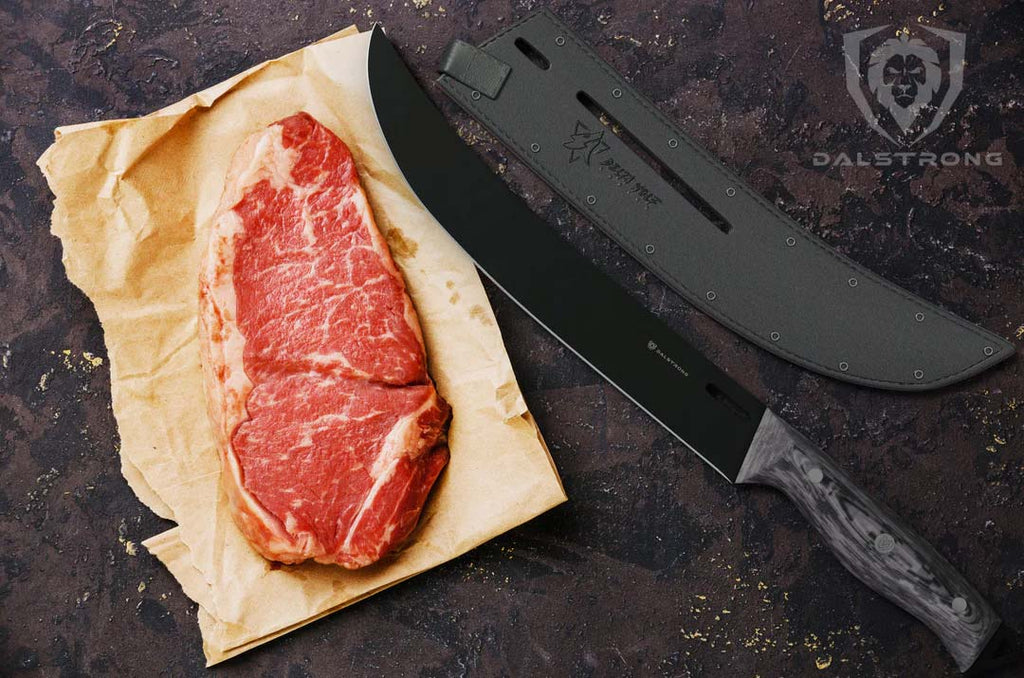 Butcher & Breaking Knife 10" | Delta Wolf Series | Dalstrong
Butcher & Breaking Knife 10" | Delta Wolf Series | Dalstrong
Understanding why it's essential to cut against the grain is like discovering the magic trick to make your meat super tasty! So, let's dive into the flavorful world of meat and find out why this cutting technique is a game-changer.
Imagine your favorite cut of meat, maybe a yummy flank steak or a tasty skirt steak. Now, think of these meats like a bundle of tiny threads, and these threads are the muscle fibers. The direction these fibers run is what we call the "meat grain." It's like a secret map hidden in your meat!
Importance of Slicing Correctly
Let's explore why this slicing superhero move is so important:
Tender DelightNow, let's be honest, every superhero has a kryptonite, and so does this slicing technique. But don't worry; it's just a tiny inconvenience:
Learning CurveIn the grand kitchen adventure, understanding the importance of cutting against the grain is like having the ultimate culinary superpower. So, grab your slicing tool, follow the meat grain map, and get ready to impress your taste buds and dinner guests with perfectly sliced, tender, and flavorful masterpieces!
3. How To Cut Against The Grain
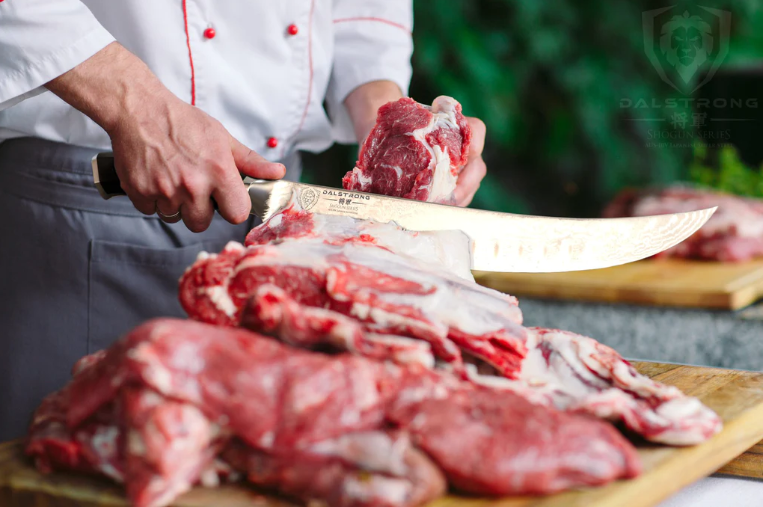 Butcher's Breaking Cimitar Knife 10" | Shogun Series ELITE | Dalstrong
Butcher's Breaking Cimitar Knife 10" | Shogun Series ELITE | Dalstrong
Now that we understand the "why," let's dive into the step-by-step guide on "how" to cut against the grain:
- Choose the Right Cut. Before you start slicing, choose a cut of meat. Flank steak, skirt steak, hanger steak – these are perfect candidates for practicing the art of cutting against the grain. Look for the direction in which the muscle fibers run.
- Locate the Grain. Examine the surface of the meat to identify the direction of the muscle fibers. The grain usually appears as lines or threads. Once you've located the grain, you're ready to move on to the next step.
- Set Up Your Cutting Station. Ensure you have a clean and sturdy cutting board. A sharp knife is your best friend for this task. A dull knife might tear the fibers instead of cleanly slicing through them.
- Slice Against the Grain. Place the meat on the cutting board with the grain lines visible. Now, it's time to start slicing. Remember, the goal is to cut perpendicular to the direction of the muscle fibers.
- Start with a Sharp Knife. A sharp knife is crucial for clean cuts. If your knife is dull, it can make the process more challenging and affect the tenderness of the meat.
- Slice at a Right Angle. Imagine the grain lines as roads. Your knife should be like a car driving across these roads at a right angle. Make sure each slice goes against the grain.
- Consistent Thickness. Aim for uniform slices to ensure even cooking. Consistency in thickness allows for a more predictable cooking time and results in a beautifully presented dish.
- Serve and Enjoy. Once you've conquered the art of cutting against the grain, arrange your perfectly sliced meat on a plate. Whether you're grilling, pan-searing, or incorporating it into a delicious recipe, you'll notice the difference in tenderness and flavor.
Tips and Tricks:
Let the Meat Rest
Allow the meat to rest before slicing. This helps the juices redistribute, ensuring a moist and flavorful result.Experiment with Different Cuts
Practice cutting against the grain with various cuts of meat. Each cut may have its unique grain pattern, and mastering them will make you a slicing pro.Use the Right Tools
Invest in good-quality knives. A sharp, well-maintained knife makes the slicing process smoother and more enjoyable.Practice Patience
Cutting against the grain might take a bit of practice. Be patient with yourself, and soon you'll be effortlessly creating perfect slices every time.
Read about the best way to store meat, here.
4. Best Dalstrong Product Recommendations
1. Fillet & Boning Knife 6.5" | Phantom Series | Dalstrong
Unlock precision and ease in your kitchen with the Phantom Series 6.5” Fillet & Boning Knife by Dalstrong. Crafted from Japanese AUS-8 steel and featuring a razor-sharp 13-15° edge, this knife effortlessly glides through beef, pork, fish, and wild game.
PROS:
- The curved blade with rockhollow divots ensures minimal drag and reduced friction for seamless bone and joint maneuvering.
- Japanese AUS-8 steel at 58 HRC provides superior durability and stain resistance.
- The D-shaped handle offers superior hand control, comfort, and agility, complemented by a sanitary build for busy kitchens.
CONS:
- Some users may find the knife's partial tang design less preferable compared to full tang alternatives.
2. BBQ Pitmaster & Meat Knife 8" | Shogun Series ELITE | Dalstrong
Elevate your BBQ experience with the Shogun Series 8” Pitmaster Knife. A masterpiece of precision and versatility that is meticulously handcrafted with high-carbon Japanese AUS-10V Super Steel. It also features a unique forked tip, bottle opener, and 13 shallow dimples for efficient slicing and serving, all in a visually stunning Tsunami Rose’ pattern.
PROS:
- The forked front end and bottle opener add unparalleled versatility to your BBQ toolkit.
- The 13 shallow dimples minimize suction, keeping juices inside and making slicing effortless.
- The military-grade G10 handle provides life-long durability, impervious to heat and moisture, ensuring a reliable grip even in the most challenging grilling conditions.
CONS:
- Some users may find the forked tip less necessary for certain slicing tasks, making it a matter of personal preference.
3. Slicing & Carving Knife 12" | Shadow Black Series | Dalstrong
Carve with precision and style using the Shadow Black extra-long 12” slicer. It's a versatile knife with ultra-sharp 7CR17MOV-X steel and hand-sharpened to 16-18° per side. It boasts a non-reflective titanium-nitride coating for corrosion resistance and a tall blade height for easy food preparation.
PROS:
- The black titanium-nitride coating not only enhances the blade's toughness but also provides excellent corrosion resistance.
- The full tang construction adds incredible robustness and quality to the knife's overall durability.
- The fiber-resin military-grade G10 handle, nearly impervious to heat, cold, and moisture, offers maximum comfort and maneuverability.
CONS:
- Some users may find the 16-18° per side sharpening angle less suitable for certain delicate slicing tasks.
4. Bull Nose Butcher Knife 10" | Shogun Series ELITE | Dalstrong
Master the art of meat carving with the Shogun Series 10” Bull Nose Butcher’s Breaking Knife. This knife stuns a scalpel-like sharpness at an 8-12° angle, exceptional edge retention at 62+ Rockwell, and a stunning Tsunami Rose blade pattern for both performance and stand-out beauty.
PROS:
- The rounded-tip design increases blade strength, ensuring precise and efficient cutting through flesh, cartilage, and fat.
- The AUS-10V Japanese super steel core delivers ultimate sharpness, making it a go-to knife for any butcher's tasks.
- With a full tang construction and triple riveting, this knife is built for maximum robustness, ensuring a lifetime of reliable use.
CONS:
- The intricate copper mosaic pin, while enhancing beauty, may require extra care during cleaning to maintain its appearance over time.
5. Slicing & Carving Knife 12" | RED Edition | Dalstrong

Unleash culinary excellence with the Shadow Black Series 12" Slicing & Carving Knife. This head turner features a razor-sharp 7CR17MOV-X steel blade, precision-forged for optimal maneuverability, a menacing black titanium-nitride coating for corrosion resistance, and an inspired handle design reminiscent of the F-117 Nighthawk Stealth Fighter.
PROS:
- The sleek and aggressive design, inspired by the F-117 Nighthawk Stealth Fighter, delivers optimal maneuverability with sharp, aerodynamic lines.
- The black titanium-nitride coating not only enhances corrosion resistance but also toughens the blade, adds non-stick properties, and contributes to the knife's striking appearance.
- The precision-forged 7CR17MOV-X steel blade, hand-sharpened to 16-18° per side, guarantees clean, precise cuts with excellent edge retention.
CONS:
- Some users may find the 12" blade length less suitable for smaller kitchen tasks, requiring additional precision during use.
5. Frequently Asked Questions
How do you know which way the grain runs in meat?
To determine the direction of the grain in meat, observe the lines or fibers running through the meat; they indicate the grain's direction.
How do you cut corned beef against the grain?
When cutting corned beef against the grain, identify the direction of the fibers and slice perpendicular to them for tenderness.
How do you cut raw flank steak against the grain?
To cut raw flank steak against the grain, locate the muscle fibers and slice perpendicular to them for a more tender result.
How do you cut raw meat?
When cutting raw meat, use a sharp knife and follow hygiene practices, ensuring clean surfaces and proper food safety measures.




